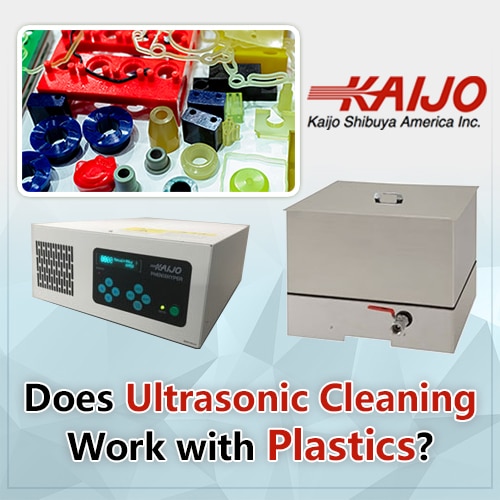Does Ultrasonic Cleaning Work with Plastics?
August 18, 2021
 While ultrasonic cleaning works best on parts with hard surfaces, such as those made of metal, many parts with softer surfaces can still be cleaned ultrasonically as well. Most plastic parts have comparatively soft surfaces and many have other characteristics that make them less suitable for ultrasonic cleaning. Parts made of light, soft plastic with simple shapes can often be cleaned better by hand. When parts have complex shapes with openings and dead-end holes, ultrasonic cleaning may still be the best solution. An experienced ultrasonic cleaner manufacturer can help find an ultrasonic cleaning solution for even difficult plastic part cleaning applications.
While ultrasonic cleaning works best on parts with hard surfaces, such as those made of metal, many parts with softer surfaces can still be cleaned ultrasonically as well. Most plastic parts have comparatively soft surfaces and many have other characteristics that make them less suitable for ultrasonic cleaning. Parts made of light, soft plastic with simple shapes can often be cleaned better by hand. When parts have complex shapes with openings and dead-end holes, ultrasonic cleaning may still be the best solution. An experienced ultrasonic cleaner manufacturer can help find an ultrasonic cleaning solution for even difficult plastic part cleaning applications.
Ultrasonic Cleaning Effectiveness Depends on the Kind of Plastic
The main factors that determine the effectiveness of ultrasonic cleaning systems for plastic parts include the following:
- Plastic Rigidity. If the plastic is soft and flexible, such as low-density polyethylene, the plastic material will flex with the ultrasonic waves and absorb some of the cleaning power, reducing cleaning performance.
- Plastic Density. Low-density plastics may float in the cleaning solution, leaving some surfaces exposed and not cleaned. To clean these parts an upside-down basket is needed to hold them under the cleaning solution surface.
- Surface Hardness. When part surfaces are soft, the ultrasonic cleaner has to operate at a higher frequency to reduce cleaning intensity and avoid surface pitting. The reduced cleaning intensity required for cleaning soft plastic parts increases the cleaning time and reduces cleaning effectiveness.
- Degree of Contamination. The reduced cleaning intensity due to cleaning at higher ultrasonic frequencies means light contamination such as powder left over from the injection molding of the plastic part can be removed quickly. Heavier contamination will take longer.
- Plastic Composition. To speed up ultrasonic cleaning at higher frequencies, the cleaning solution is often heated and mild solvents are sometimes added to remove specific contaminants. Plastics that can withstand the heat and the solvent cleaning action without deforming or suffering surface damage will be easier to clean with an ultrasonic cleaner.
For a specific plastic part cleaning application and a corresponding contaminant, the manufacturer of ultrasonic cleaning systems can often design an effective solution. They can determine which frequencies will be the most effective and can recommend solvents based on their experience. If simple washing or manual cleaning of some plastic parts is the best solution, they will advise against using ultrasonic cleaners.
Some Plastic Parts Require an Ultrasonic Cleaning Solution
Even if some plastic parts are not ideally suited for ultrasonic cleaning, their shape may require an ultrasonic cleaning solution to get the parts completely clean. Hard-to-clean plastic parts such as computer keyboards, complex printer components, or some medical devices are almost impossible to clean completely without an ultrasonic cleaner.
Ultrasonic cleaning works by generating microscopic cavitation bubbles in the cleaning solution. The bubbles produce a scrubbing action against the surfaces of the parts to be cleaned. Because the bubbles appear everywhere the cleaning solution can penetrate, ultrasonic cleaning can clean inside threaded holes, interior spaces, and cracks. Parts with complex shapes may be almost impossible to clean without this ultrasonic penetrating action. If the part is made from plastics that are otherwise not ideal for ultrasonic cleaning, the ultrasonic cleaning system manufacturer may be able to design a custom solution that is effective for a specific application.
Let Kaijo Help You Select the Right Ultrasonic System for Cleaning Your Plastic Parts
Kaijo has extensive experience in ultrasonic cleaning and can deliver custom-built ultrasonic cleaning solutions for customers. Let our experts help you choose the right system based on your specific cleaning requirements. As one of the leading ultrasonic cleaner manufacturers, we work with customers in many industries that have unique cleaning requirements. We help customers determine their requirements and provide advice and solutions from our complete range of ultrasonic cleaning systems and components. Once designed, built, and delivered, we will ensure the ultrasonic cleaner meets your needs and that the system works as expected.





